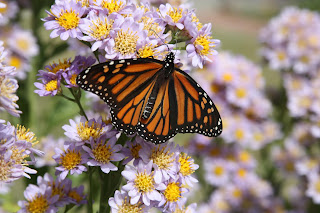Aster Tataricus Fall Beauty
Fall is for asters and they are popping up in lawns at 2-inches tall and in gardens topping out at 10 feet tall. In between there are dozens of other Aster heights to chose from when deciding which ones to plant.
Aster Tataricus is large, with toothed leaves and hundreds of light blue flowers with yellow centers. This variety spreads, creating colonies and providing October-November nectar for hundreds of butterflies.
In a sunny location, a cluster of Aster Tataricus can have 20 Monarch butterflies at a time, swaying in the breeze on the Asters’ strong stems while sunbathing and collecting strength to continue their voyage south.
For the most part the stems can stand without staking but when we have a big wind and rain storm they will fall over. Usually, we do not bother to stake them since the skippers, butterflies and bees cover the flower heads just as much.
Even though the flowers are only an inch wide, the large clusters are a beautiful addition to flower beds.
Aster Tataricus is reliable in most soils and is cold hardy in zones 3 to 9.
As with most plants from Asia (Siberia to Japan) they have to be divided and thinned regularly. In China the roots are used in treatments for colds and infections.
Pruning Asters mid-spring can keep them compact, making them suitable for the middle of a bed. There is also a hybrid called Dwarf Tatarian Jindai that matures at 4 feet tall.
Tatarian Asters are herbaceous perennials, meaning that the roots and rhizomes live for many years but the plants disappear in the winter. When the leaves emerge in the spring they grow quickly and some garden writers say they look like a bed of Swiss Chard or tobacco because the leaves are so large.
Gardeners who grow Tatarian Asters usually have plants to share. Just ask for some roots so your garden will attract and feed migrating butterflies next November.




Comments